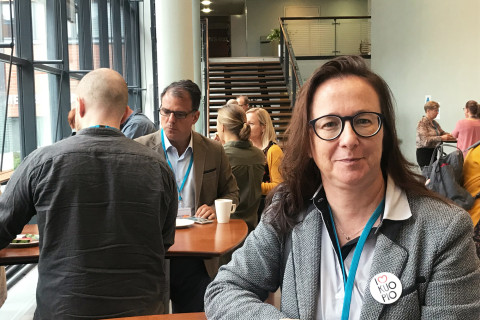Recent studies indicate that there is a connection between frontotemporal dementia and dysfunctions in the immune and neurotransmitter systems. The FinFTD symposium in Kuopio, Finland also covered other prospects in the fields of diagnostics and care of frontotemporal dementia patients.
The Finnish FTD Research Network (FinFTD) promotes cooperation between researchers of frontotemporal dementia (FTD) and other forms of frontotemporal lobar degeneration (FTLD). In addition to researchers, the target audience of the network’s first major symposium in Kuopio on 13 September included healthcare professionals who work with the FTD patients.
FTD is the second most common memory disorder among people of working age. A significant proportion of FTD cases are hereditary, and among Finnish patients, a repeat expansion mutation in the gene C9orf72 that is linked with the disease is exceptionally common. Early symptoms of FTD include changes in behaviour and personality, and problems with the memory only arise once the disease progresses. The development of diagnostics is also held back by the lack of appropriate biomarkers. “The variety of symptoms experienced by the carriers of the C9orf72 mutation is considerably wide, which means that psychiatric misdiagnoses are very common,” says Anne Remes, professor at the University of Oulu.
From cell models to clinical research
In the symposium, Remes presented Finnish research and new initiatives in the field, such as the FiNeFTD project, which studies the mechanisms of FTD and the link between the length of the C9orf72 repeat expansion and the progression of the disease by analysing clinical cases and nerve cells created with applications of stem cell technology from the skin cells of patients and control subjects. The joint project led by Remes and Research Director Annakaisa Haapasalo is funded by the Academy of Finland.
According to Haapasalo, the FinFTD network is an excellent example of synergy between basic research and clinical research. “We are able to use both pre-clinical disease models, such as the stem cells of patients, as well as carefully characterised patient cases in studying the mechanisms of FTD and identifying new biomarkers and potential drug targets.”
Haapasalo’s research group at the A.I. Virtanen Institute of the University of Eastern Finland is the only group in Finland that conducts basic research on the mechanisms of FTD. Haapasalo presented the group’s research on the effects of the C9orf72 repeat expansion on a cellular and molecular level. The research focuses on the effects of the C9orf72 repeat expansion on not only nerve cells, but also on the glial cells that support the nerve cells.
Recent studies show that FTLD is also linked to changes in the function of the immune system. Bachelor of Medicine and doctoral student Kasper Katisko from the University of Eastern Finland presented the results of a study in which the prevalence of immunological diseases on Finnish patients with FTLD was studied. According to the results, cancer is less common in this group, but certain autoimmune skin diseases are more common than in control groups. In addition, the study shows that changes in certain immunological mediators in the blood may correlate with the clinical characteristics of patients and the progression of the disease.
“Early symptoms of FTD are more varied than those taken into account in the current diagnostic criteria. For instance, some patients experience problems with memory in the very early stage of the disease,” says Eino Solje, MD and Research Group Director at the University of Eastern Finland.
The study results presented by Solje indicate that the early stages of FTD may be linked with episodic memory problems. In addition to headaches and dizziness, sleep problems and disturbance of the circadian rhythm, in particular, are more common than in cases of Alzheimer’s disease. According to Solje, surprisingly common symptoms also include somatisation, the inexplicable manifestation of physical symptoms, most commonly in the form of symptoms in the nose or throat.
Promising biomarkers
The keynote speaker of the symposium, professor Alberto Lleó from the Hospital de la Santa Creu i Sant Pau of Barcelona said that the early detection of FTD and the ability to distinguish between its subtypes is a prerequisite for targeted treatment of the patients in the future. “The diagnostics of Alzheimer’s disease has been studied more extensively, and the disease can already be detected in a much earlier stage than before with the help of cerebrospinal fluid biomarkers.”
Lleó mentions neurofilaments as an example of a promising biomarker of FTD. The concentration of neurofilaments in cerebrospinal fluid is even higher than in cases of Alzheimer’s disease. “In addition, the concentration correlates with the progression of the disease and changes in the brain.” Contemporary methods allow measuring the concentration of neurofilaments also from a blood sample.
“Nevertheless, the disease spectrum also includes genetically different forms of the disease, and the biomarker profile may depend on the genetic form of the disease.”
Can the disease be delayed?
“For carriers of the disease-associated mutations, the most important question is when the disease will affect me – at an older or earlier age than my parents,” said another keynote speaker of the symposium, Associate Professor Barbara Borroni from the University of Brescia, Italy.
Borroni presented the GENFI study network that studies the factors that determine the age of the onset of the disease in carriers of GRN, MAPT and C9orf72 mutations. “The results imply that a high level of education may delay the onset of the disease.” From the perspective of health policy, an important observation is that also environmental factors may have an effect on the age of onset.
“The goal is to target any new treatment options to people who are at risk of developing the disease even before they experience any symptoms.”
FTD is linked with changes in the activity of the brain’s neurotransmitter systems, which, according to Borroni, opens new possibilities in both diagnostics and treatment. “For instance, the decreased GABAergic neurotransmission can be detected up to 20 years before any symptoms occur. According to our observations, it can also be used to predict the progression of the disease.”
Studies have shown that the activity of neurotransmitters can be stimulated by transcranial magnetic stimulation administered on the surface of the head.
For more information, please contact:
Annakaisa Haapasalo, annakaisa.haapasalo (a) uef.fi
Anne Remes, anne.remes (a) oulu.fi
Eino Solje, eino.solje (a) uef.fi



